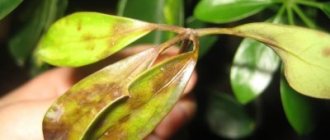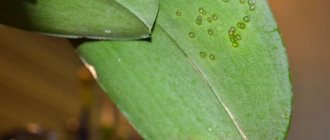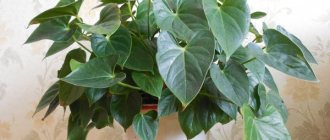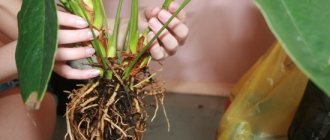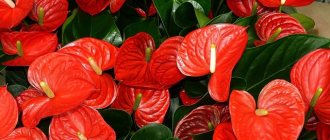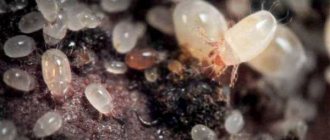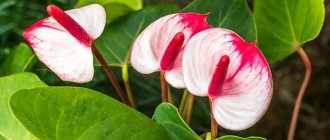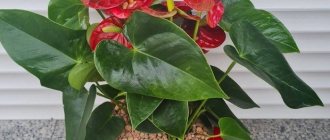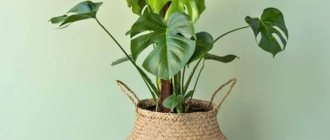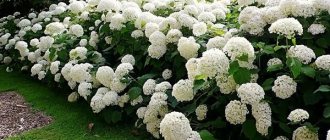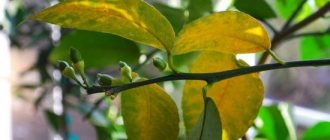Tips of anthurium leaves drying out
Often, gardeners are faced with the problem of the tips of anthurium leaves drying out, which causes reasonable concern.
The tips of dried leaves lead to a rapid increase in the area of damage to the leaf blade and complete loss of the leaf. The plant may lose all its leaves if you do not respond promptly and make changes to agricultural practices. Understanding the reasons why anthurium leaves dry out will allow for effective treatment. Dried tips of the leaves indicate insufficient air humidity in the room. Another equally common cause is poor aeration of the root system.
Treatment for anthurium with dry leaf tips involves more frequent spraying. A pot with a houseplant is placed away from heating radiators. Place a container of water next to the pot to increase air humidity.
Aeration of the root system depends on the composition of the soil and the material from which the flowerpot is made. Dense soil and insufficient drainage holes do not allow the roots to “breathe.” Anthurium should be transplanted into a clay pot
It is important to use a special composition for epiphytic plants for planting.
Other problems when growing anthurium
The size of leaves and flowers is affected by the age of the plant. The older the anthurium, the smaller and paler the flowers. The trunk becomes more bare every year as the leaves below die off. Some types of anthurium continue to grow luxuriantly, but with small rosettes, and some with a single rosette of leaves.
To help the plant continue to bloom profusely with large flowers, it needs to be rejuvenated. Using a sharp knife, cut the top of the anthurium so that you get a cutting with two or three aerial roots. Plant it in soil prepared in advance. In order for the cutting to develop better, before planting it can be placed in a growth stimulator for some time. You need to care for the cuttings systematically, spraying them with warm water.
Often gardeners are faced with the fact that anthurium not only dries out, but also does not bloom. This problem leads to:
- lack of lighting;
- incorrect temperature conditions;
- too high air temperature in winter;
- incorrect watering procedure;
- low humidity in the room;
- the presence of dry inflorescences on the plant.
Now you know why anthurium leaves turn black or yellow, and also what to do in such situations. The plant may also change leaf color to yellow, brown or another color due to improper care or pest attack.
Therefore, it is important to provide the flower with proper care, timely watering, fertilizing, and replanting as necessary. If you notice that the leaf blades of a plant are changing their color, do not ignore it.
It is important to determine the cause of the problem and eliminate it in time to save the anthurium.
Video: Stretched violets: what to do?
The Anthurium genus contains up to 900 (according to some estimates up to 1500) species and is deeply appreciated by lovers of indoor flowers of the Araceae family (this includes plants such as alocasia, philodendrons, monsteras, syngoniums, scindapsus, zamioculcas, dieffenbachia, aglaonemas, spathiphyllums, anubias, cryptocorynes, colocasia and etc.). All types of anthuriums are loved for their beautiful leathery, shiny, large leaves and unusually shaped flowers that resemble swallowtails.
Decorative species are usually grown at home, including Hucker's anthurium, Veitch's anthurium, crystal anthurium, climbing anthurium, which is used for vertical gardening. The most popular are Andre's anthurium and Scherzer's anthurium, in which the inflorescence is characterized by a pronounced veil.
Anthurium is a wayward plant. To grow it and maintain a well-groomed appearance, it is necessary to use special soils, which will, moreover, be filled with substrates (you can make them at home yourself or purchase them in specialized stores), have a drainage system, because this plant does not like to be flooded or dry out , therefore, a system of optimal soil care must be present. In nature, anthurium grows in loose soil with the remains of rotted wood, which is constantly ventilated and not oversaturated with moisture. However, at home it is recommended to use soil for orchids or violets (coal, peat, bark or sphagnum) with the addition of high-moor peat, perlite and leaf humus. Instead of high-moor peat, you can use store-bought peat, but do not purchase low-lying soil, because it is completely unsuitable for growing anthuriums.
If the rules for choosing and caring for the soil are followed, the plants will delight you with their extraordinary beauty, otherwise, if the soil is oversaturated with water, improper care, or failure to comply with the appropriate criteria for room care and location, the anthurium may “catch” a viral disease and suffer from rot in the soil. roots, stems, infestation with parasites. How to check if everything is ok with your anthurium? If you notice cracked leaves, inclusions of yellow spots, tubercles, white rot on the roots, yellowing, or falling leaves, then the rules for maintaining the plant have been violated.
How to apply for the purchase of anthuriums
It is advisable to send the application in writing to [email protected] We can accept applications by phone 89379684236 (Megafon) from 10.00 to 20.00 (Moscow time).
In your application, indicate the names (or numbers) of the selected anthuriums and the desired price of the plant (division size). The letter must include your full name, postal address with zip code and mobile phone number. The application is not binding; you can adjust (add or remove plants) and even refuse the order. Please note that the quantity of some varieties of anthuriums is limited. After receiving your application, we will contact you by phone to clarify the order details, cost, and delivery. After agreeing on the order, we will provide payment details (100% prepayment only) and send your plants by Russian Post, from the beginning of spring to the end of autumn, depending on the region.
Other plants:
You can buy different varieties of anthuriums in our nursery. We place all anthurium babies in a temporary pot (plastic cup), so the anthurium purchased from us must be transplanted into a permanent pot after receiving the parcel. Watch the video, it clearly shows how to do this.
Soil and peas for anthurium
Anthuriums require soil consisting of several components. How to make a substrate for anthurium, and what pot to choose for this flower.
Homemade anthuriums: description and care
Have you purchased anthurium seedlings from our nursery? Be sure to read this material. In this article you will find a description of anthurium and recommendations for caring for, growing, and replanting them at home.
Anthuriums: Andre, Crystal, Scherzer
Description and cultivation of these three main types of indoor anthuriums at home.
Abutilon: description of the flower and how to buy seedlings
In this article you will find a description of the abutilon plant and recommendations on how to grow and propagate indoor maple at home.
Hibiscus Classic Pink - description and sale
Rooted hibiscus cuttings Classic Pink - 300 rubles. Blooming hibiscus seedling Classic Pink - 600 rubles.
Buy hibiscus Creole Lady
Rooted hibiscus cuttings (depending on the variety) - from 300 to 500 rubles. Blooming hibiscus seedling - 600 rubles.
Geranium Black Barahat
You can buy a rooted cutting from our nursery (300 rubles) or a flowering plant of Black Velvet geranium (600 rubles).
Coleus plant
Coleus is an ornamental perennial plant. Description of the coleus flower and recommendations for care and cultivation. Buy coleus.
Pachistachis: reproduction and care
How to propagate Pachistachis at home. Recommendations for growing and care. Sale of rooted pachistachis seedlings.
Why is this happening and what to do?
Incorrect temperature
Anthurium is a plant from humid, hot countries. In winter, the optimal temperature for flower viability is only eighteen degrees, and in summer, despite the flower’s homeland, it is considered normal if the mark on the thermometer does not exceed twenty-six degrees. At the same time, anthurium does not like drafts and easily freezes in them.
If, nevertheless, the leaves begin to dry out due to the wrong temperature, you urgently need to create comfortable conditions for the anthurium: move it to a colder/warmer place where drafts will not reach the flower - this is monitored especially carefully.
Important! Be sure to reduce watering if the flower freezes slightly.
Illiterate watering
Having discovered that the tips are drying out due to the quality of the water, due to too many salts and heavy metals in it, you should not hesitate and switch to watering with another liquid with a better composition. An option is to infuse water: running water is poured into a bottle and left for two to three days. After a few days you can use it for watering: the composition improves, the liquid becomes less harmful. The main thing is that the water is at room temperature.
Pests
Anthurium is often “attacked” by mites, scale insects or mealybugs. Having found traces of insects on the stem, leaf blade, leaf petioles and axils, gardeners treat the anthurium with a soap solution. A gram of nicotine sulfate is added per liter of water. A day after treatment, the plant is washed with clean water. Beforehand, flower growers take care to protect the soil from waterlogging during the procedure.
A solution of pyrethrum, tobacco tincture or Karbofos can also help in the fight against parasites.
Fungus
It affects not only the leaves, but also the root system of the plant. When dry spots appear all over the leaf, the anthurium is removed from the pot and its roots are examined (we talked more about the reasons for the appearance of various spots on anthurium leaves here)
If they suddenly turn from white/light brown to brown or black, and the tissues become soft and slimy, then the plant is replanted, but before that it is important:
- remove soil residues;
- cut off damaged leaves;
- trim fungus-affected roots to healthy tissue;
- treat the cuts with crushed coal;
- treat the entire plant with a fungicide.
After moistening the soil, excess liquid is poured out, and before the next watering, wait for the top layer of soil to dry out.
Potty doesn't fit
Anthurium, the reason for the drying leaves of which was the lack of free space in the pot, and therefore the lack of oxygen, requires an emergency transplant. The new container should be two to three centimeters larger in diameter; it is advisable to add more coarse fraction to the soil: cones, pieces of brick or charcoal.
If desired and at the right time, the plant is rejuvenated and replanted.
Lack or excess of fertilizers
Violation of the feeding regime and their quantity leads to drying out of the tips of anthurium leaves. If this happens, it is necessary to check the recommended rate and amount of fertilizers usually given to the plant.
Excess nutrients in the soil cannot be corrected. In this case, the plant is transplanted into “poorer” soil and the recommendations for the use of fertilizing are strictly followed. The deficiency is compensated by increasing the dose of fertilizing.
The soil is not suitable
Too dry soil or, conversely, waterlogged soil can lead to unpleasant consequences for anthurium, including its death
Therefore, it is important to follow the watering regime and not overwater the anthurium. It is necessary to promptly remove excess accumulated water from the pan, monitor the quality of drainage and dry air
A quickly drying substrate indicates dry air. Then they try to moisten it in every possible way:
- spray the plant with water at room temperature;
- wipe the leaves (but do not allow drops to linger on the leaf plate - the anthurium can cause a burn);
- shade the plant, because the sun's rays, especially direct ones, not only harm the leaves, but also dry out the soil.
In summer, it is recommended to place the pot on a wide tray with damp coarse sand or pebbles. When watering with water from a tap, the composition of the soil can change, and an excess of fertilizers has the same effect. In the first case, the anthurium is watered with water that has been infused for several days, in the second case it is replanted and then the amount of fertilizing given is monitored.
On our website you have the opportunity to learn about what diseases can affect anthurium and why its leaves may turn yellow.
Flower age
Most often, leaves turn yellow due to aging. Age-related changes affect more the foliage that is located closer to the ground surface. In this case, the yellowness spreads throughout the entire leaf, due to which elasticity and juiciness are lost, the leaves become brown. After some time, they disappear on their own if they are not removed first. If the plant is well cared for and properly cared for, the loss of old foliage will not harm the flower, because healthy young leaves will begin to grow at the top.
Yellowing leaves do not benefit the plant, they only take away its strength; it is better to cut them off in time. If you remove the old leaves, the flower will begin to develop and become attractive. To cut dead leaves, it is recommended to use scissors or a knife treated with alcohol so as not to introduce infection into the stem. Sprinkle the cut area on the trunk with crushed charcoal. When the leaves have turned yellow but have not lost their juiciness, they cannot be torn off by hand so as not to injure the main stem, so use a sharp tool for this purpose.
Popular articles Champignons on a diet: nutritional value and beneficial properties
Causes of blackening of anthurium leaves
Improper care and temperature conditions of the plant often lead to the leaves of anthurium turning black. To figure out what reason affected the plant, the article will analyze in detail all the possible ones.
Diseased anthurium
Diseases
A variety of diseases can appear in both indoor and garden crops. Anthurium is not immune to diseases either. If the leaves have dried out, spots or plaque have appeared, then such a plant should go into quarantine until it recovers, so as not to harm the other flowers. Treatment should be started as soon as possible.
The first possible problem is rust. It begins to appear first on the stems and leaves, looking like brown spots of different sizes. As a result, the leaves fall off, and after some time the plant completely disappears. This happens in dry air.
Septoria is a fungal disease that actively develops in warm and humid environments. Yellow spots and brown edges appear, the leaves dry out quickly.
Soil fungi infect roots, which rot and wither. The appearance is associated with the use of infected soil, or the plant was already infected upon purchase. Overwatering and improper drainage in the pot are also causes.
For your information! If you do not treat the flower by removing the affected parts, then only a stump will remain from the plant.
Powdery mildew appears as a white coating. There is a difference between false and real. The latter is treated with fungicidal agents. It appears due to high humidity at high temperatures, sudden temperature changes, and improper care. When pale small pimples appear, it is necessary to begin treatment for mealy fungi.
Fusarium and gommosis are also found in anthurium. The reason is poorly disinfected soil.
Affected leaves
Anthurium can also turn black from the caescospora fungus. It is not so dangerous for the plant, but it can affect its appearance. It first appears in the form of yellow spots, which then turn brown, eventually the leaves dry out and fall off.
Pest attack
Another reason why anthurium leaves turn black is an attack by pests. The main parasites are scale insects, aphids, thrips, and spider mites.
Scale insects are tiny, armored bugs that are very difficult to spot. It is necessary to carefully care for the plant. These bugs deprive the indoor flower of energy, and as a result it withers and dies.
Thrips larvae can be seen on the back of the leaf, they look like black dots. They can infect a plant at any time of the year, but are more active in spring and summer. Larvae and adult thrips are also dangerous.
Important! All flowers affected by pests must be quarantined. The main signal of aphid appearance is leaves that are sticky to the touch.
Aphids are insects that multiply very quickly throughout the plant.
The main signal of aphid appearance is leaves that are sticky to the touch. Aphids are insects that multiply very quickly throughout the plant.
If a cobweb is seen on a flower, it means that a spider mite has settled on it. It leads to drying of all parts of the anthurium - leaves, flowers, shoots.
Wrong fertilizer
Black spots may appear from the use of fertilizers that contain a large amount of calcium. A lack of boron, zinc and iron and an excess of calcium lead to rapid aging of the plant.
Anthurium needs to be fertilized once every 3 weeks in spring and summer. These flowers are very sensitive to both an excess of lime and an excess of minerals. Therefore, fertilizing should be diluted.
Improper watering
Leaves darken at the edges if not watered correctly. It is unacceptable to water with cold tap water and with a high lime content. In summer, water with warm water at room temperature; in winter, the water temperature should be 18 °C.
Watering
Lack and excess of anthurium nutrition
If the plant has slowed down and its young leaves are smaller than those that opened earlier, the anthurium is likely suffering from a nutrient deficiency. A lack of basic elements, such as nitrogen, phosphorus or potassium, causes anthurium leaves to turn brown. A similar effect can be expected if the substrate lacks calcium or magnesium.
To feed anthuriums, liquid ready-made products are used, which are used weekly to restore a damaged plant, using a 25% concentration of that recommended by the manufacturer. When the pet gains strength, it needs to be fertilized every two weeks.
Sometimes not only a deficiency, but also an excess of fertilizers causes the development of yellow and brown spots on anthurium leaves. If there is an overdose of fertilizing, it is better to replant the plant in new soil, having first washed the root system.
What other spots may appear on anthurium and why?
The appearance of uncharacteristic spots on anthurium leaves indicates a disease of the species. It is possible to understand the cause and decide on treatment only after a thorough examination of the leaf plate.
Yellow spots
Yellowing of the leaf blade can occur when the plant is infected with chlorosis. It appears due to a lack of the following microelements: iron and magnesium. For treatment, you should remove the damaged leaves and urgently apply a complex fertilizer enriched with the necessary substances to the soil.
Yellow spots
On a note! It is possible to make an accurate diagnosis by the appearance of the leaf. With chlorosis, the veins remain green, and the leaf turns completely yellow.
Black spots
If the transplant procedure was carried out incorrectly or an unsuitable substrate for this species was used, black spots may appear on the anthurium.
The soil for this species is selected taking into account the individual preferences of the plant. For example, intended for bromeliads or orchids.
Leaf blackening
White spots
When anthurium is infected with powdery mildew, a white coating appears on the leaves.
This disease occurs at high temperatures and high humidity in the room.
This disease is easily treated in the early stages with ordinary fungicides.
Powdery mildew
How to properly care for anthurium to avoid brown spots
Why do hydrangea leaves turn yellow and the edges dry out - causes and treatment
In order for anthurium to delight with lush flowering and a juicy, green tint of glossy leaf plates, it must be properly cared for, following a number of recommendations:
- A suitable place to place a flowerpot with a plant is partial shade. Lighting should be plentiful, but diffuse.
- Temperatures in summer are up to 25 °C; in winter, anthurium will be comfortable at temperatures from 14 °C to 16 °C.
- Drafts are detrimental to the plant; they should not exist.
- Watering is carried out with soft, warm water. Frequency in the summer months - 2 times a week, with the onset of cold weather once every 7 days. The water drains from the pan after 15-20 minutes.
- The humidity in the room should be high. To ensure comfortable growth of the plant, it must be sprayed frequently.
- Fertilizing is introduced 2 times a month. Mineral complex or organic fertilizers are used.
- It is recommended to make the soil yourself, mixing 1 part peat and 2 parts each of leaf soil and humus.
Anthurium will thank you for proper care with its beauty.
Attention! When watering and spraying, it is necessary to avoid getting water on the inflorescences.
Anthurium is a magnificently beautiful plant with lush flowering. Despite the fact that it is considered rather capricious to grow, it does not require the creation of specific conditions. The appearance of brown spots on the leaf blades indicates that the plant has not been properly cared for. You can revive anthurium if you create a comfortable environment for it and eliminate the factors that provoke the disease.
What to do if anthurium leaves are covered with brown spots
If the leaf plates of the plant begin to turn brown, you need to determine what exactly led to the appearance of this symptom and begin to treat the anthurium:
- Incorrectly selected soil characteristics - replanting in the right soil.
- Sunburn - moving the pot to partial shade.
- Incorrect watering - adjusting the watering schedule.
- Pest attack - use of folk remedies or insecticides.
- Damaged roots - replanting with removal of bad roots.
Additional Information! The effect of a draft on the plant can lead to the appearance of brown spotting. When ventilating the room, it is recommended to take the anthurium to another room.
In order not to encounter diseases, it is necessary to immediately take proper care of the anthurium.
Prevention measures
Proper care of green pets allows you to avoid a lot of problems. Timely and rational watering, sufficient fertilization, optimal lighting and air temperature will allow the flower to feel good and delight the owner with its beautiful blooms.
Unlike fungal diseases, which often appear due to improper care, parasitic diseases damage even well-cared for plants. To avoid many problems, you need to carefully monitor the anthurium and inspect the leaves for pests.
For preventive purposes, it is recommended to give the plant a shower from time to time and wash it with a solution of laundry soap. And if pests are nevertheless noticed, it is necessary to immediately begin to combat them.
What to do to prevent diseases and pests?
The foliage turns yellow and falls off after fungal diseases. The most common:
- septoria;
- downy mildew;
- rust;
- anthracnose
Disease prevention includes
- regularly wiping the leaves with a damp cloth;
- creating comfortable humidity by spraying water from a spray bottle;
- maintaining the correct temperature.
Moist, non-drying soil is a favorable environment for fungi and putrefactive bacteria. Anthurium does not like both insufficient watering and excess moisture.
Due to the aging of the flower, brown spots and drying of the leaves are considered normal. It is necessary to eliminate errors in care and ensure normal growth conditions. When brown spots appear due to fungus and pests, the flower is treated with special preparations. Prevention of diseases and preservation of the attractive appearance of anthurium is achieved with good care and maintenance.
Previous
Diseases What to do if the buds of an indoor hibiscus fall off? Reasons why this happens Next Diseases Why does the Crassula shed its leaves and die? How to save your favorite plant?
Pests
We continue to look at why the anthurium leaves are covered with brown spots. If the leaves are covered with light brown, yellow spots and begin to curl, this indicates that the flower has been attacked by aphids. If you want to save the plant, it must be treated with special means or tobacco tincture.
If the shoots are covered with cracks and the leaves are stained, then the flower has been attacked by a mealybug. To combat it, karbofos is used. Dark brown spots on the leaves appear due to a scale insect attack. Such pests must be removed manually, and the flower must be treated with a solution of laundry soap and kerosene.
What are Anthurium diseases and the causes of their occurrence?
Violation of sanitary standards
The root cause of diseases is the owner’s attitude towards the purchased indoor plant. The flower needs time to adapt to new conditions. The plant requires individual observation to exclude infection.
To keep your flowers healthy, you need to isolate all newly purchased indoor plants from other crops for 2 weeks and keep them in quarantine conditions. During this period, healthy plants adapt and continue their growth and development. Patients will show external signs of the disease.
Disease groups
Diseases of indoor plants are divided into 2 groups: non-infectious and infectious.
Non-infectious diseases are the result of a violation of the maintenance of a flower in conditions that do not meet its requirements. Such diseases do not affect other plants. When the source of the disease is eliminated, they recover without causing damage to other crops.
Infectious diseases cause pathogenic infections that necessarily affect other plants. Changing hosts, pathogenic fungi, bacteria and viruses multiply quickly and in a short time can destroy almost all nearby plants.
Buy a rooted baby or flowering anthurium
You can buy one blooming Anthurium, depending on the variety and age of the flower, in the range from 600 to 700 rubles. A rooted shoot (baby) of anthurium can be purchased from 350 rubles. If the cost of ordered indoor flowers (plants) is 3,000 rubles or more, then we add one plant for free. The minimum amount for any purchase is 1000 rubles.
We do not send plants by cash on delivery!
For the availability of anthuriums in our nursery, see the “Anthurium Catalog” section.
When choosing anthuriums, instead of the name, you can indicate the number of the flower in the photo.
Catalog of anthuriums: photos and descriptions.
Plant care
The air around the plant should be well humidified. It needs to be sprayed a lot and often, and sometimes the foliage needs to be wiped with a damp cloth. To strengthen and develop the growth of adventitious roots, you need to cover the stems with moss. If you comply with all the requirements, the anthurium will bloom magnificently all summer.
In spring and summer, the flower grows, it needs to be fed, fed every 15 days, alternating organic and mineral fertilizers. The flower is replanted annually in the spring (if the base of the flower is more than 25 cm wide, replant it once every six months).
There are many reasons why flowers can become pale and small. This can be either a consequence of improper care or one of the signs of illness. Before taking active action, you need to find out the cause, and then effectively eliminate it.
Anthurium leaves turn yellow, how to save the plant
If a flower is given as a gift, you cannot place it with all the indoor plants in the house at once. 2 weeks of quarantine, if everything is in order, you can reunite the anthurium with all the specimens on the windowsill. If signs of disease or pests appear, it is first treated or replanted.
When choosing a flower yourself, you need to pay attention to the appearance, condition of the inflorescences, leaves, and stems. When yellow leaves appear, it is advisable to immediately remove the anthurium from the soil and inspect the roots - the reason most often lies in them. If there are rotten areas, it means that watering was carried out incorrectly according to some parameters - they are described above.
Lack of fertilizing for a lushly blooming anthurium for 2 - 3 months can lead to a deterioration in appearance. Complex mineral fertilizers for decorative deciduous plants are suitable. It is not recommended to exceed the dosage. On the contrary, it is better to give a weakened anthurium a smaller dose, but add three feedings per month.
Share
Fungal diseases
As mentioned above, anthurium is a moisture-loving plant, so it has a high chance of becoming infected with mycoses. These are diseases caused by microscopic fungi that love moist environments.
Downy mildew (peronospora)
Whitish, yellowish spots appear on the leaves of anthurium, so familiar to gardeners. Cucumbers are often affected by this disease. The formation of gray spores can usually be observed on the reverse side of the leaf.
The source of this common disease is a microscopic fungus that is extremely sensitive to air humidity. The main condition for getting rid of this parasitic fungus is a decrease in air humidity in combination with the use of contact fungicidal preparations (Topaz, Acrobat).
Rust
The disease affects anthurium leaves. Chlorotic spots of a rusty hue appear on the outer surface, and active sporulation occurs on the lower surface. Just as in the case of downy mildew, the main method of combating and preventing leaf rust is maintaining optimal air humidity. For prevention, you can use biological fungicides, for example, Albit, Alirin, Fitosporin.
An anthurium leaf affected by rust must be treated with a fungicide.
Fusarium wilt
This type of mycosis inhibits the entire plant. The fungal nature of anthurium wilting is revealed by a pinkish-white coating that forms on the root collar. The causative agent of the disease is species of fungi of the genus Fusarium.
Unfortunately, Fusarium infection occurs in many ways, including through water and air. And the fungal spores are extremely tenacious and resistant to high temperatures and chemicals. Therefore, the main thing in the fight against fusarium is prevention, for example, adding the antifungal drug Glyokladin to the soil. Systemic fungicides Vitaros, Rovral, Fundazol have also proven themselves well in the fight against fusarium.
Fusarium wilt affects the entire plant
Septoria
This common fungal disease appears on the leaves as brown spots, sharply outlined by a yellow rim. Subsequently, the leaves wilt and the plant dies. The main treatment is treating anthurium with copper-containing fungicidal preparations (Bordeaux mixture, copper sulfate, Kuproxat).
Brown spots with a yellow rim on anthurium leaves are a sign of septoria
Anthracnose
Another disease of anthurium that is fungal in nature. The leaves begin to dry out and become thinner. Dry brown spots may appear from the edges or in the middle of the leaf blade. If urgent measures are not taken, the plant will dry out quite quickly and soon die.
With anthracnose, anthurium leaves begin to dry out at the edges
Treatment should be carried out using systemic fungicides (Fundazol, Acrobat, Ridomil Gold). It is also necessary to treat the soil containing fungal spores with fungicidal preparations. If the anthurium could not be saved, the remaining indoor plants should be protected. The fungal spores are extremely tenacious, so the vacated pot must be heated. If this is not possible, then you will have to get rid of such dishes.
Late blight
Anthurium is quite rarely affected by late blight; nightshade plants are still more often affected by this disease. Despite this, if you notice small purple-brown spots on the leaves, you need to take immediate action. Late blight develops very quickly and affects the root system, dooming the plant to rapid death.
The best option for controlling late blight is to use systemic fungicides. These include Fitosporin-M, Fundazol, Alirin-B, Previkur. In this case, you will definitely have to replace the soil, rinse the roots thoroughly under water, and heat treat the pot or replace it with a new one. The roots can also be treated with a weak solution of potassium permanganate.
Basic care mistakes
Anthurium can hardly be called a capricious plant, but mistakes in cultivation can be disastrous for it. Here are the main signs that you can use to understand that something is wrong with your plant.
Table: main anthurium diseases and their causes
| Signs | Causes | |||
| Diseases | Pests | Nutritional imbalances | Other reasons | |
| Leaves turn yellow | — | Spider mites, aphids | Chlorine in irrigation water |
|
| The leaves turn black | — | — | Too much calcium in the soil |
|
| Brown spots on leaves | Septoria, rust | Aphid | — |
|
| Black spots on leaves, brown tubercles | — | Shchitovka | — | — |
| Brown spots with a yellow rim | Septoria | — | — | — |
| The plant is drying up | Anthracnose | — | — | Lack of moisture in the soil or air |
| Dark spots on leaves | — | Thrips | — |
|
| Purple-brown spots on leaves | Late blight | — | — | — |
| Yellow, faded leaves | — | — | Lack of nutrients in the soil |
|
| Pimples on leaves | — | — | Excessive watering | |
| Cobwebs on leaves | — | Spider mite | — | — |
| The leaves are turning pale | — | — | Lack of nutrients in the soil |
|
| White chlorotic spots on leaves | Downy mildew | — | — | — |
| Small flowers/leaves | — | — | Lack of microelements in the soil | Insufficient watering |
| Massive yellowing, leaf dieback, or root rotting | Fusarium wilt | — | — | Prolonged excess moisture |
| The leaves are curling | — | Aphid | — |
|
| The leaves are fading | Septoria | Scale insect, thrips | — | — |
| Leaves “cry” after watering | — | — | — | A combination of abundant watering and moist air (guttation) |
| White coating on leaves | Powdery mildew | — | — | — |
| Pinkish coating on the root collar | Fusarium wilt | — | — | — |
| Deformed leaves | — | Trips | — | — |
| Torn leaves | — | — | — | Dry air |
| Sticky leaves | — | Shchitovka | — | — |
| Flowers turn green | — | — | Lack of nutrients in the soil | — |
| The flowers are drying up | — | — | Insufficient nutrients in the soil | Dry air |
| Pimples on peduncles | — | Shchitovka | — | — |
| Doesn't grow | — | — | Lack of nutrients in the soil |
|
| The plant is withering | — | Aphids, scale insects, thrips | Nutritional deficiencies | Insufficient watering |
| The flower does not take root | — | Aphids, scale insects, thrips | Lack of nutrients in the soil | — |
| Anthurium trunk rotted | Fusarium wilt | — | — | Excessive watering |
| The growing point has rotted | Fusarium wilt | — | — | Excessive watering |
| Anthurium dries up | — | — | — |
|
| Anthurium does not bloom | — | — | — |
|
| The leg of the anthurium turns black | — | — | — | Excessive watering |
| The plant is falling apart | Mycoses | — | — | Excessive watering |
| Slowly growing | Damage by pests, diseases | Lack of nutrients in the soil | Lack of lighting | |
Errors in anthurium care are usually easy to correct (replace the plant from the battery, water more or less, feed, change the windowsill, etc.), but dealing with dangerous diseases and pests is not so easy.
Yellow spots
Leaves turn yellow in winter due to lack of light. This phenomenon can also be caused by watering with water containing chlorine, as well as heavy metal oxides. If you want to avoid yellowness, it is recommended to water the plant with rain, melted water or pre-settled water at room temperature. If water accumulates in the pan, the roots will begin to rot and the leaves will turn yellow. It is necessary to moisten the soil moderately and remove excess liquid from the pan. A flower in a small pot may also produce yellow leaves. Then it must be transplanted into the largest container.
